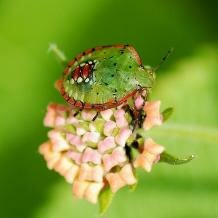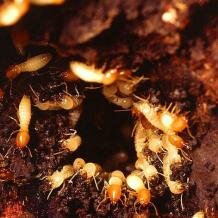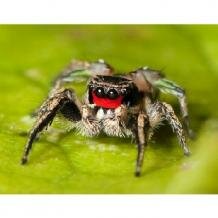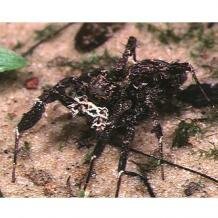Topic: Vibrational communication in insects and spiders
Some spiders have evolved a most remarkable method of capturing other spiders – they imitate the vibrations of insects caught in their victim’s web. And this is only one of numerous intriguing examples of vibrational communication in arthropods…
Numerous animals use vibrations propagating through a substrate to communicate with conspecifics, predators or prey. This mode of communication has reached extraordinary heights in insects and spiders, where it is both highly sophisticated and remarkably diverse in function. Vibrational signals are probably not very costly to produce for such small animals, whereas the effective generation of air-borne sound is constrained by body size. However, the vibrations created by insects and spiders do not range further than a few metres, but relative to the size of these arthropods this is actually quite substantial. Until recently, vibrational communication had received very little attention, but now a growing number of studies is revealing more and more examples and roles of vibrational signals.
Insects
Vibrational signalling is amazingly widespread in insects and has evidently evolved multiple times in this group. It has been estimated that more than 90% of those species that use some form of mechanical disturbance propagating through a substrate (including air-borne sound) rely on vibrations, and more than 70% exclusively so. Most vibrational signals are species-specific, but they can also vary between the sexes or even individuals. They differ markedly from air-borne insect sounds, usually consisting of fairly pure tones that are low in frequency.
Signal generation, transmission and reception
There are different ways of producing vibrations, but it always involves movements of the body or specific structures. When body parts are thumped directly against the substrate, this is known as percussion (or drumming), whereas tremulation refers to a transmission of body movements to the ground via the legs.  Also tymbal mechanisms, which entail a membrane, and stridulation, where two body parts are rubbed together, can be used to create seismic signals. Often different methods are combined.
Also tymbal mechanisms, which entail a membrane, and stridulation, where two body parts are rubbed together, can be used to create seismic signals. Often different methods are combined.
As most insects are herbivorous and usually live on their host plants, the majority of vibrational signals are transmitted through plant stems. Here, communication occurs on a local scale, typically ranging from 30 cm to about 2 m. It has been suggested that vibrational signals might be adapted to transmit through particular plants, but support for this idea has been mixed. While it was initially assumed that the seismic channel is a rather quiet one, it is now appreciated that insects communicate in a complex vibrational environment. Not only do they have to filter out the substrate-borne signals of other con- and heterospecifics, but there is also disturbance from background noises such as wind, rain and air-borne sounds produced by other animals (e.g. birdsong).
The primary vibration receptors of insects are found in their legs. Campaniform sensilla, which are usually located near the joints, have comparatively low sensitivity, whereas the subgenual organ in the tibia is extremely sensitive. Its structure is complex and varies between different groups. Also an organ in the antennae named Johnston’s organ that is involved in olfaction might in at least some circumstances be involved in the detection of seismic signals.
Functions of vibrational signals
The functions of insect vibrations are manifold. Within species, they play a major role in mating, but are also related to alarm and defensive behaviour as well as coordinating interactions between members of social groups.
 The importance of substrate-borne signals in species recognition, mate localisation and pair formation is well documented in many different insect orders. During courtship, male and female southern green stink bugs (Nezara viridula) often exchange stereotyped sex-specific vibrational signals in a duet. But signals have also been shown to differ between individual males, thus affecting male-male competition and female choice. In some bush-crickets (Tettigoniidae), they function as an indicator of body size, and females prefer the signals of larger males. Bush-crickets are better known for using air-borne sounds during courtship, but substrate vibrations make it easier for females to localise a stridulating male, thus providing an additional communication channel. Vibrational signals can also be associated with parental care, for example in some treehoppers (Membracidae), where females protect their offspring from predators in response to a synchronised group signal.
The importance of substrate-borne signals in species recognition, mate localisation and pair formation is well documented in many different insect orders. During courtship, male and female southern green stink bugs (Nezara viridula) often exchange stereotyped sex-specific vibrational signals in a duet. But signals have also been shown to differ between individual males, thus affecting male-male competition and female choice. In some bush-crickets (Tettigoniidae), they function as an indicator of body size, and females prefer the signals of larger males. Bush-crickets are better known for using air-borne sounds during courtship, but substrate vibrations make it easier for females to localise a stridulating male, thus providing an additional communication channel. Vibrational signals can also be associated with parental care, for example in some treehoppers (Membracidae), where females protect their offspring from predators in response to a synchronised group signal.
 Caterpillars of the family Drepanidae employ vibrations in competitive interactions. The solitary larvae of the common hook-tip moth (Drepana arcuata) are territorial, defending a silk nest site on a leaf from conspecifics. They engage in ritualised “duels” with intruders, during which they produce vibrations by drumming and scraping their mandibles as well as specialised anal structures against the leaf. Larvae of a moth (Semiothisa aemulataria) in the family Geometridae can distinguish between the vibrations made by abiotic factors and other herbivores and those of predators and respond appropriately. They lower themselves to safety by a silk thread only when threatened by a predator and even vary thread length in accordance with the potential risk.
Caterpillars of the family Drepanidae employ vibrations in competitive interactions. The solitary larvae of the common hook-tip moth (Drepana arcuata) are territorial, defending a silk nest site on a leaf from conspecifics. They engage in ritualised “duels” with intruders, during which they produce vibrations by drumming and scraping their mandibles as well as specialised anal structures against the leaf. Larvae of a moth (Semiothisa aemulataria) in the family Geometridae can distinguish between the vibrations made by abiotic factors and other herbivores and those of predators and respond appropriately. They lower themselves to safety by a silk thread only when threatened by a predator and even vary thread length in accordance with the potential risk.
 In group-living insects, vibrational communication is probably crucial for solving the challenges of feeding on plants, such as facilitating cooperative foraging and avoiding predation. Immature stages of a sap-sucking treehopper (Calloconophora pinguis) feed in sibling groups on young expanding leaves that are highly nutritious but present an ephemeral food source. These hemipterans thus need to repeatedly find new feeding sites, which has led to the evolution of a particularly efficient resource-finding mechanism. A few “scouts” locate expanding leaves and recruit their siblings by means of plant-borne vibrations. Newly recruited individuals then signal synchronously with those already there until all group members have arrived. Such an acoustic food signalling system involving a highly coordinated group display has to date not been documented in other insects.
In group-living insects, vibrational communication is probably crucial for solving the challenges of feeding on plants, such as facilitating cooperative foraging and avoiding predation. Immature stages of a sap-sucking treehopper (Calloconophora pinguis) feed in sibling groups on young expanding leaves that are highly nutritious but present an ephemeral food source. These hemipterans thus need to repeatedly find new feeding sites, which has led to the evolution of a particularly efficient resource-finding mechanism. A few “scouts” locate expanding leaves and recruit their siblings by means of plant-borne vibrations. Newly recruited individuals then signal synchronously with those already there until all group members have arrived. Such an acoustic food signalling system involving a highly coordinated group display has to date not been documented in other insects.
 Eusocial insects such as ants and termites employ vibrations in many different contexts. Foragers of the leafcutter ant Atta colombica generate plant-borne signals when cutting leaves (especially if they are of high quality) to recruit other colony members. Substrate-borne vibrations in the subterranean termites serve as alarm signals in response to predators but, remarkably, also to pathogenic fungal spores that might peril their agricultural system. Chains of drumming soldiers transmit the alarm over long distances, employing periodic re-amplification so the signal is not lost (analogous to nervous transmission and human methods such as beacons). Termites are evidently very sensitive to vibrations and even use them to assess the size of a piece of wood that they shred for food.
Eusocial insects such as ants and termites employ vibrations in many different contexts. Foragers of the leafcutter ant Atta colombica generate plant-borne signals when cutting leaves (especially if they are of high quality) to recruit other colony members. Substrate-borne vibrations in the subterranean termites serve as alarm signals in response to predators but, remarkably, also to pathogenic fungal spores that might peril their agricultural system. Chains of drumming soldiers transmit the alarm over long distances, employing periodic re-amplification so the signal is not lost (analogous to nervous transmission and human methods such as beacons). Termites are evidently very sensitive to vibrations and even use them to assess the size of a piece of wood that they shred for food.
Vibrational signals can furthermore be involved in the communication between species. Some butterfly caterpillars in the family Riodinidae that live in symbiosis with ants (e.g. Thisbe irenea) generate substrate-borne vibrations with specialised papillae. These vibrations attract the ants, which protect the defenceless caterpillars from predators and receive nutritious secretions in return. However, vibrations can also betray an insect’s location to a predator or parasitoid. “Vibrational eavesdropping” by, for example, spiders is likely and some insects (e.g. grasshoppers in the genus Taeniopoda) have been shown to employ “vibrocrypticity”, meaning that they walk past a spider very slowly, generating only little vibration in the substrate.
Spiders
Spiders are the other arthropod masters of vibrational communication. Many species possess very sensitive mechanoreceptors in their cuticle, the so-called slit sense organs. These small grooves deform in response to mechanical stimuli, such as strains imposed by movement and vibrations. Of course, vibrations produced by insects caught in a spider’s web alert the owner to the presence of a meal, but there are much more intriguing things going on…
 Jumping spiders (Salticidae) were thought to be visual specialists, as they possess remarkably sophisticated eyes and employ elaborate visual signals during courtship. Males of the species Habronattus dossenus, however, produce a complex repertoire of multi-component seismic courtship signals as well, using coordinated movements of their legs and abdomen. These seismic signals were shown to strongly affect male mating success. Not only were experimentally muted males three times less likely to mate than unmanipulated males, but they also had higher pre-mating cannibalism rates and longer latency to copulation (which we can assume is highly disadvantageous). Multimodal displays could have been favoured by selection, since they might be more reliable and flexible than signals in a single modality and might thus allow, for example, faster mate choice decisions. It has now been confirmed that many other Habronattus species produce a variety of seismic courtship signals, which could have played a role in the diversification of this speciose genus.
Jumping spiders (Salticidae) were thought to be visual specialists, as they possess remarkably sophisticated eyes and employ elaborate visual signals during courtship. Males of the species Habronattus dossenus, however, produce a complex repertoire of multi-component seismic courtship signals as well, using coordinated movements of their legs and abdomen. These seismic signals were shown to strongly affect male mating success. Not only were experimentally muted males three times less likely to mate than unmanipulated males, but they also had higher pre-mating cannibalism rates and longer latency to copulation (which we can assume is highly disadvantageous). Multimodal displays could have been favoured by selection, since they might be more reliable and flexible than signals in a single modality and might thus allow, for example, faster mate choice decisions. It has now been confirmed that many other Habronattus species produce a variety of seismic courtship signals, which could have played a role in the diversification of this speciose genus.
The brush-legged wolf spider Schizocosa ocreata also combines visual and seismic signals during courtship. In this species, seismic signals are likely to indicate male quality, particularly body condition. Initially, it was suggested that the two signal types are largely redundant, probably serving as “backup” to each other, which might be adaptive in the spider’s complex leaf-litter habitat where signal transmission is likely to be impaired. Later studies in the closely related sister species S. stridulans, however, provided evidence that only the seismic signal is important for mating success, thus representing a rare example of a single component probably dominating a multimodal signal.
 In dancing white lady spiders (Leucorchestris arenicola) of the Namib Desert, vibrations seem to be involved in male-male competition. Males of this species go on long excursions, during which they often mate with females they encounter. When approaching another male’s territory, they signal with intense sand drumming, thus possibly causing the rival to withdraw.
In dancing white lady spiders (Leucorchestris arenicola) of the Namib Desert, vibrations seem to be involved in male-male competition. Males of this species go on long excursions, during which they often mate with females they encounter. When approaching another male’s territory, they signal with intense sand drumming, thus possibly causing the rival to withdraw.
Jumping spiders in the genus Portia feed on other spiders, which they capture by invading their webs and mimicking the vibrational signals of caught insects. This is a particularly intriguing case of aggressive mimicry. Portia exploits a wide range of spider species and it has been shown that it uses a trial-and-error method (which is uncommon in invertebrates) to find the appropriate vibrational signals for each species. Portia fimbriata even imitates the vibrational signals of males of other spider species to attract and then prey on the females.
Cite this web page
Map of Life - "Vibrational communication in insects and spiders"
https://mapoflife.org/topics/topic_584_vibrational-communication-in-insects-and-spiders/
April 22, 2021

